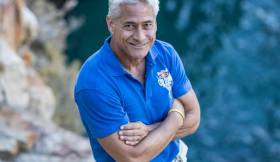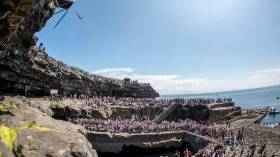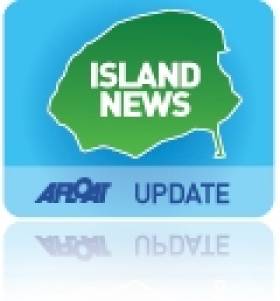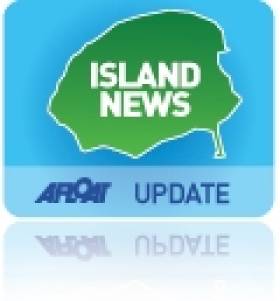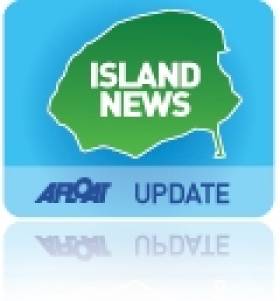Displaying items by tag: Cliff Diving
Red Bull Cliff Diving World Series Set to Make First Stop in Northern Ireland on Causeway Coast
For the first time ever, this summer Northern Ireland’s Causeway Coast will welcome the Red Bull Cliff Diving World Series.
Positioned in the World Series calendar as a major mid-season shake-up, the fourth stop of 2024 from 18-20 July has multiple take-off spots lined up throughout the event — a challenge that will surely test the divers to their limits.
In the opening rounds, dives will launch directly off the cliffs at both Kinbane Castle and from the iconic cove known as ‘Lord’s Prayer’. The competitors will then wrap up the final two rounds by diving from the purpose-built platforms constructed in Ballycastle Harbour.
Though the Causeway Coast is a first for 2024’s diver line-up, the World Series has previously hosted five stops “down the road” on the island of Ireland, most recently in 2021 — 180 miles from Ballycastle at Downpatrick Head, Co Mayo where the divers plunged into the rough waters of the Atlantic Ocean.
With coastal conditions prone to throwing challenging conditions into the mix at any given time, expect the mid-season stop to serve up plenty of twists and turns and dramatic battles, as the divers fight for cliff-diving supremacy.
For more details, see the Red Bull website HERE.
Red Bull Cliff Diving World Series at Downpatrick Head Was A Record Breaker (Photo Gallery)
On a weekend that will go down in cliff diving history, a record 23 tens (top scores) were handed out, two perfect dives were recorded in a single stop for the first time ever, and Carlow Gimeno became the first diver ever to perform a handstand dive directly off the rocks during the first round
Ireland hosted the fourth of the six-stop 2021 Red Bull Cliff Diving World Series on Sunday, 12th of September at the historic and picturesque location of Downpatrick Head, Mayo. 24 of the world’s best cliff divers faced possibly their toughest test yet as they leaped, twisted and somersaulted from heights of up to 27m and at speeds in excess of 85km/h, off the rugged cliffs and into the wild Atlantic below.
Four-time World Series champion, Australia’s Rhiannan Iffland secured first place in the women’s competition with 391 points on her 11th consecutive win. Rhiannan blew her rivals out of the water with a sensational ‘perfect dive’, earning five 10s from the judges for the first time in her career. The first woman to achieve this feat, she also surpassed her own record for the highest single dive score.
Joining Iffland on the podium were Canada’s Jessica Macaulay in second place and a fellow Aussie, wildcard Xantheia Pennisi, who put on a career-best display to make the top three for the first time.
Record Breaking Weekend as the Red Bull Cliff Diving World Series by INPHO/Red Bull/Morgan Treacy
“It feels great to be on top of the podium once again,” said Iffland. “I was feeding a little bit from my training partner Xantheia Pennisi as well. Coming into the last two rounds today it was neck and neck and I think I really ate up the pressure and I enjoyed it. That dive in warm up it didn’t go so well, so I decided I had to switch my mindset for the competition and made sure that I gave it my absolute all. I went through the water and went ‘wow, that really worked’. I’m super stoked and I guess I’ve got to figure out ways to spice it up and keep pushing myself. I guess I can kind of relax a little bit now and enjoy the competitions a little bit more. Saying that, I still want to go out there and give it my all to break those scores again. This is what I’m aiming for next.”
In the men’s competition, France’s Gary Hunt secured his 41st victory in the Red Bull Cliff Diving World Series. The eight-time world series champion won with 442.50 points. Romania’s Constantin Popovici, Hunt’s closest competitor this season, earned four tens for his third-round dive. In the final round, English prodigy Aidan Heslop grabbed two, Italy’s Alessandro De Rose picked up three, while the Spanish wildcard Carlos Gimeno wowed viewers with a first-ever perfect handstand dive, becoming only the third man ever to receive five 10s from the judges.
It is testament to Hunt’s character, ability and all-round mental strength that he managed to hold off this marauding challenge from the chasing pack to climb back on top of the podium again. Popovici took second place, while De Rose made the top three for the first time since 2017.
“From Italy I expect fireworks,” said Hunt after his win. “I feel like everyone is really getting into their stride. You’ve seen how many 10s have been awarded this competition and everyone is getting comfortable. It will be really, really tough, but that’s what I love about this sport. It’s going to get tougher every year and let’s hope to finish this season with a bang.”
The divers will continue their fight for the King Kahekili trophy at the first stop of an Italian doubleheader in Puglia on 22nd September.
Results – Stop #4, Downpatrick Head, IRL:
WOMEN
1- Rhiannan Iffland AUS – 391.60pts.
2- Jessica Macaulay CAN – 343.80
3- Xantheia Pennisi (W) AUS – 338.20
4- Molly Carlson CAN – 316.80
5- Eleanor Smart – 302.80
6- Antonina Vyshyvanova (W) UKR – 289.85
7- Meili Carpenter (W) USA – 269.30
8- Jaki Valente BRA – 240.20
9- Iris Schmidbauer GER – 179.75
10- Adriana Jimenez (W) MEX – 110.00
MEN
1- Gary Hunt FRA – 442.50pts.
2- Constantin Popovici ROU – 433.60
3- Alessandro De Rose ITA – 419.55
4- Carlos Gimeno (W) ESP – 395.40
5- David Colturi USA – 393.10
6- Michal Navratil CZE – 378.20
7- Aidan Heslop (W) GBR – 368.15
8- Steven LoBue USA – 343.65
9- Sergio Guzman (W) MEX – 342.95
10- Catalin Preda (W) ROU – 341.05
11- Andy Jones USA – 333.70
Standings* (after 4 of 6 stops)
WOMEN
1- Rhiannan Iffland AUS – 600pts.
2- Jessica Macaulay CAN – 420
3- Molly Carlson (W) CAN – 346
4- Xantheia Pennisi (W) AUS – 272
5- Eleanor Smart USA – 260
MEN
1- Gary Hunt FRA – 560pts.
2- Constantin Popovici ROU – 450
3- Catalin Preda (W) ROU – 339
4- Alessandro De Rose ITA – 314
5- Carlos Gimeno (W) ESP – 232
*The Oslo Exhibiton did not count towards the Red Bull Cliff Diving World Series standings.
The Red Bull Cliff Diving World Series is set to return to Ireland on 12 September, with Downpatrick Head in Co Mayo hosting the fourth stop on this year’s international circuit.
It’s one of the four new locations for the elite cliff diving competition, along with spots in France, Norway and the Caucasus.
It also marks the fifth Irish edition of the event — following three visits to Inis Mór in the Aran Islands and 2019’s contest in Dun Laoghaire, which attracted an estimated 145,000 spectators.
Elite divers representing 18 nationalities will take part in the 2021 series, which kicks off at Cap Dramont, south-west of Cannes on France’s Mediterranean coast, on 12 June.
The athletes then head to Oslo in Norway (14 August) and Mostar in Bosnia and Herzegovina before their Irish stop, continuing on to Polignano a Mare in southern Italy (26 September) and Baku in Azerbaijan (16 October).
Greg Louganis Set For Red Bull Cliff Diving On Inis Mór
#CliffDiving - World famous Olympic diver Greg Louganis will attend the Red Bull Cliff Diving World Series event in the Aran Islands later this month as the competition’s new sports director, as Galway Bay FM reports.
The five-time world champion and four-time Olympic gold medallist will arrive on the island of Inis Mór ahead of the globe’s cliff diving elite, who make their return to Poll na Péist — also known as the Serpent’s Lair — on the first stop of this year’s world tour, as previously reported on Afloat.ie.
All tickets for live spectators have been snapped up for the contest on Saturday 24 June, but the action will be livestreamed online via Red Bull TV.
Cliff Diving World Series Returns To Aran Islands In 2017
#CliffDiving - The Red Bull Cliff Diving World Series returns to Poll na Péist this summer, as the Offaly Express reports.
Also known at the Serpent’s Lair, the spectacular blowhole in the Aran Islands last hosted cliff diving’s top flight in June 2014.
Saturday 24 June will mark the third visit of the global tour to the islands since 2012, and is just one of six stops worldwide in the 2017 competition.
Reigning men’s and women’s champs Gary Hunt from the UK and Australia’s Rhiannan Iffland are expected to lead the cream of the sport to Inis Mór for the first stage of the new season before stops in Portugal, Italy, Texas, Bosnia and Chile.
The Offaly Express has more on the story HERE.
#CliffDiving - The Red Bull Cliff Diving World Series will make its long-awaited return to Ireland this summer after dazzling spectators in the Aran Islands two years ago.
As the Belfast Telegraph reports, reigning champion Artem Silchenko and cliff diving's living legend Orlando Duque will be among those testing their mettle with the 27-metre dive into the Serpent’s Lair blowhole at Inis Mór on Sunday 29 June.
Also known as Poll na Peist, it's a spectacular dive described by Duque as one of the highlights of his career.
The Serpent's Lair will be the third stop in the 2014 Red Bull Cliff Diving World Series that began this past weekend in Havana, Cuba, where British diver Blake Aldridge went top of the table with 200 points in a huge upset victory.
Russian Wows Aran Islands Crowds at Red Bull Cliff Diving Event
#CLIFF DIVING - Russian cliff diver Artem Silchenko wowed the crowds on Inis Mor at the weekend, scoring big with a "breathtaking" new dive to take his second victory in a row in the Red Bull Cliff Diving World Series.
As the Irish Independent reports, 700 lucky spectators who won tickets to the limited-capacity event in the Aran Islands saw the 28-year-old steal the thunder from veteran diver Orlando Duque on a weekend that witnessed some spectacular 28-metre dives at Poll na Peist.
"My armstand with blind entry was brilliant and I beat by Orlando by just four points," Silchenko told Red Bull after his victory, which came just two weeks after he topped Duque to claim his first win of the series in the Azores.
"When I came to the platform after Orlando dived I saw nine and nine-and-a-halfs from the judges but I knew what I had to do for my final dive [a back triple triple].
"You know it’s a good dive only when you’re underwater. You’re travelling so fast it’s impossible to take it all in. Only after the entry can you say 'yes, it’s a great dive.'"
Silchenko had to pull out all the stops with Duque putting together his best set of dives all year. And the Colombian, whose programme included a back triple triple and his trademark reverse twister, says it bodes well for the rest of the season.
"This was probably the best competition I’ve done this year," said Duque. "It’s a challenge the way Artem is performing but I’m also doing better.
"This was my highest score of the season. If I can keep up this level then it’s going to be difficult for the others."
Nine-time world champion Duque retains the lead of the overall ranking going into the second half of the 2012 series, which next heads to Boston at the end of August.
#RED BULL CLIFF DIVING - Red Bull will publicise the risks involved with cliff diving in an effort to avoid copycat attempts by the public after its event on Inis Mór next month, said a spokesperson.
As previously reported on Afloat.ie, the Red Bull Cliff Diving World Series will make a stop in the Aran Islands on the weekend of 3-4 August, where the world's best cliff divers will converge for the season's halfway stage.
However, fears have been raised by the islands' GP after copycat attempts at a similar event in 2009 resulted in a number of serious injuries.
Video footage of that event posted on YouTube was blamed for inspiring untrained people to cliff dive with no safety or rescue personnel present. In one case this resulted in a "very serious" spinal injury, said Dr Marion Broderick.
Of particular concern is the location of the diving site at the Serpent’s Lair – ‘Poll na Peist’ in Irish – which is in an area with poor mobile phone reception, a situation compounded by the GP's lack of a handheld VHF radio.
The Irish Times has much more on the story HERE.
Red Bull Cliff Diving World Series Comes to Ireland
#ISLAND NEWS - Red Bull Cliff Diving will come to Ireland's west coast for the fourth stop of the 2012 World Series on 3-4 August.
The competition will see the world’s best cliff divers converge on the biggest of the three Aran Islands for the season’s halfway stage.
A ferry ride from Galway, Inis Mór is home to the Serpent’s Lair – ‘Poll na Peist’ in Irish – a natural formation that fishermen call a ‘blowhole’.
"What makes the Serpent’s Lair special," says Red Bull, "is that it’s a near-perfect rectangle, its inexplicable shape ensconced in Gaelic legend."
“The Serpent’s Lair is one of those places you only hear stories about,” said Colombian cliff diver Orlando Duque ahead of the first ever World Series in 2009. “Finding this place and being able to dive there was one of the highlights of my career."
Orlando’s hopes to return will surely be answered during the first weekend of August as he sets his sights on securing the 2012 title.
Other stops in this year's World Series include France on 22-23 June, Norway on 6-7 July, the Azores on 20-21 July, the USA on 24-25 August, the UK on 7-8 September and Oman on 27-28 September.


























